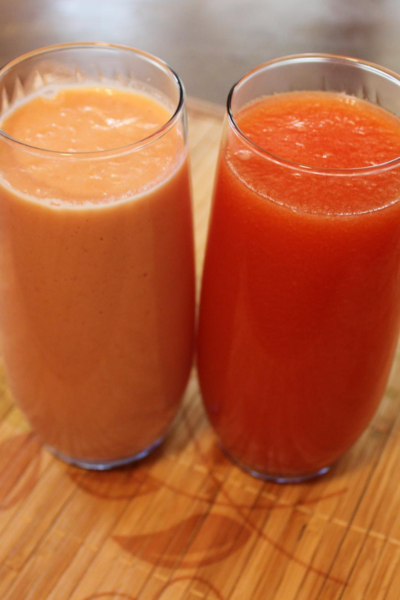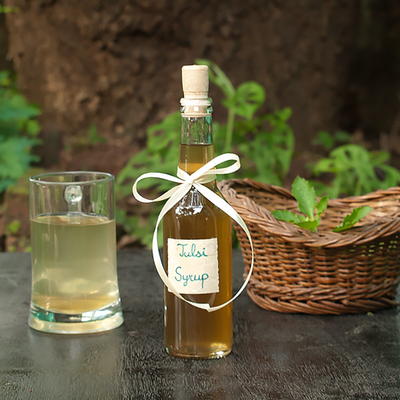Root Beer
Ingredients
- bottle brush
- bottle washer
- 5-gallon container for mixing (not aluminum)
- bottle capper
- siphon tube (at least 3 feet long)
- siphon clamp
- at least 4 dozen 12-oz bottles (be sure to use the kind which requires
- a bottle opener, because the threaded necks of the twist-off variety
- are too easily broken)
Instructions
1 packet champaign yeast (I get two, in case the first one doesn't proof) 5 lbs of table sugar 1 bottle root beer extract (regular size) at least 5 dozen bottle caps Carefully & thoroughly wash the bottles. It is best as well as convenient to first wash them in the dishwasher to loosen up and remove the primary dirt particles; then, scrub the inside of each one with the bottle brush followed by several blasts on the bottle washer to rinse it out. Inspect each bottle by holding it up to a light -- If you still see any dirt or debris stuck to it, either throw it away or attempt to clean it again (this choice is usually driven by supply versus patience). Yes, this is the biggest pain-in-the-ass part of the whole operation, but it is important to ensure each bottle is clean. Dissolve a couple tablespoons of the sugar in a cup of barely luke-warm water, and stir in the packet of yeast. After 10 minutes or so, it should start to foam up a little. This is called "proofing" the yeast. If it doesn't foam, throw it away and try again with a fresh packet. Using your 5-gallon container, thoroughly dissolve the remaining bag of sugar in 4 1/2 gallons of luke-warm water. Mix in the bottle of root beer extract. When the yeast has proofed, add it to the mixture and let it stand for at least 5 minutes. Thoroughly clean the siphon tube and affix the siphon clamp to one end. Affix a small weight (a spoon works well) to the other end of the tube and drop it into the root beer mix. Tilt the bucket by propping it up on one side with an old book or something (about 1 or 2 inches thick), and reposition the weighted-end of the tube such that it rests on the bottom-most corner of the bucket. A few clothespins strategically placed around the rim can help ensure the tube stays in place. To leave about 1 inch of head room in each bottle. Affix a bottle cap to each with the bottle capper. Any bottle that should become even slightly cracked by the capper should be discarded along with its contents. Keep the root beer in a dark place at room temperature for 2 to 4 weeks. During this period the yeast will consume sugar and produce CO2, thus carbonating the beverage (this phase is known as "conditioning"). Be careful: If it is kept too warm or left out too long, the yeast will create more pressure than the bottles can handle, resulting in a major mess when they all blow up -- it only takes one to start the chain reaction. For the root beer to achieve an acceptable level of carbonation. The actual time will vary from batch to batch due to many unknown and/or uncontrollable factors (e.g., mixing temperature, conditioning temperature, freshness/type of yeast, sugar structure). In order to monitor the progression of carbonation in the batch, you'll have to periodically sacrifice a bottle for sampling. Open the first one about 10 days after bottling, then check another one every few days after that, until the desired level of carbonation is reached -- then refrigerate the entire batch. When the root beer has achieved the desired carbonation, you You must refrigerate it, else you'll have your own Mutiny requiring Bounty. Refrigeration causes the yeast to slow down to an almost inactive level; any subsequent raise in room temperature will speed it back up again. If you continue to keep the bottles at room temperature, they'll progressively become more and more carbonated and, eventually, explode. Root beer which has been allowed to get just a bit more carbonated than intended is still quite drinkable -- you just need to be more careful when uncapping in order to avoid unintentionally decorating your ceiling (or yourself) with twelve ounces of sticky brown liquid seeking its first flying lesson. When opening a potentially fiesty bottle, you'll want to "sneak" off the pressure a little at a time by slowly raising the bottle opener until you just hear the hiss of escaping gas, then hold that position until you see foam starting to rise up above the surface of the liquid, then immediately lower the opener again -- the bottle will then reseal itself, allowing the foam to subside. Keep doing this until you sense that enough excess pressure has been bled off.
Read NextEaster Punch

















